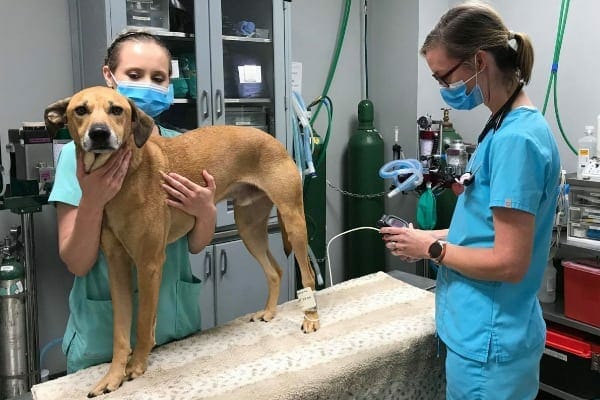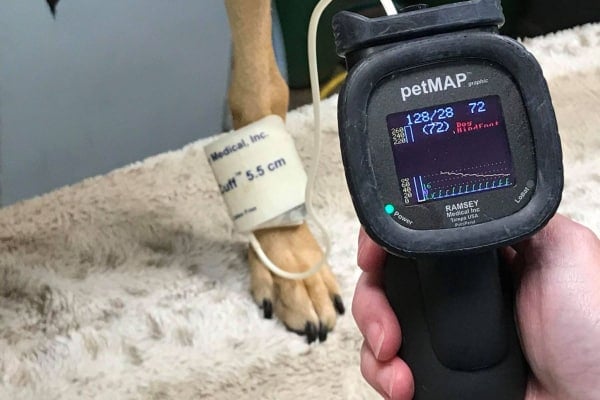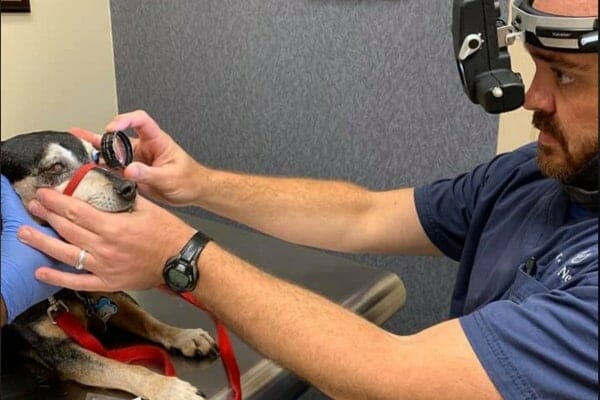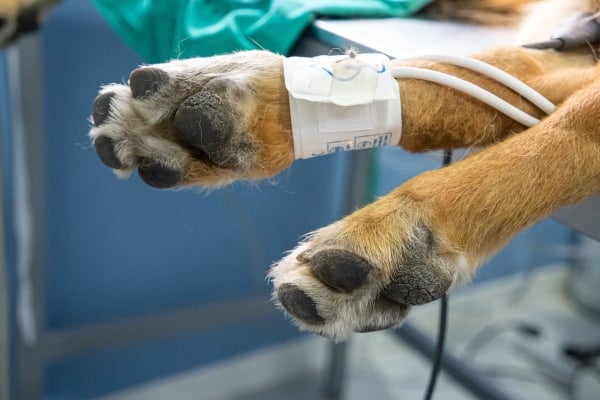Hypertension, or high blood pressure, in dogs is a warning sign and complication of many canine diseases. Recognizing the signs can be tricky, especially as your dog ages. But knowledge is power, and hypertension can be manageable. Integrative veterinarian Dr. Julie Buzby equips you to be proactive in caring for a senior dog with high blood pressure.

If you notice your dog is slowing down or exhibiting changes in behavior, how can you differentiate between normal signs of aging and something more serious like hypertension?
Knowledge is the best line of defense, so let’s break down all things hypertension. By the end of this article, you’ll know what is normal blood pressure for a dog, what is considered high, how hypertension is diagnosed, and treatment options.
- What is blood pressure?
- What is normal blood pressure for a dog?
- What is high blood pressure in dogs?
- What causes high blood pressure in dogs?
- What are the symptoms of hypertension in dogs?
- How is blood pressure measured?
- How is hypertension diagnosed in dogs?
- Is blood pressure monitoring part of a healthy dog's regular veterinary visit?
- What are the complications from hypertension in dogs?
- How to treat high blood pressure in dogs
- Can a dog parent check a dog's blood pressure at home?
- What is the prognosis for dogs with high blood pressure?
- You are most qualified to know when your dog is feeling off
- Does your beloved dog have hypertension?
What is blood pressure?
To understand hypertension in dogs, first we need to understand blood pressure. By definition, blood pressure is the measurement of the force your dog’s blood exerts against his blood vessel walls. Adequate pressure is critical to maintaining blood flow to your dog’s organs so that his or her cells are continuously supplied with life-sustaining oxygen and nutrients. Blood pressure that’s too low or too high presents problems, so knowing what’s normal is key.
What is normal blood pressure for a dog?
When looking at blood pressure values, there are usually two numbers: the top number (systolic blood pressure) and the bottom number (diastolic blood pressure). These are the same values your own doctor checks at most healthcare appointments. When assessing blood pressure, it is important to look at both of these numbers.
For dogs, normal systolic blood pressure is within a range of 110-160. Normal diastolic dog blood pressure is 60-90. This also might be written as the normal range is 110/60 to 160/90.
There is also a third number that you might hear your veterinarian mention. This is the MAP, or mean arterial pressure. The MAP is the average blood pressure through the whole body for one cycle of the heart pumping. The normal MAP blood pressure for dogs is 85-120.
What is high blood pressure in dogs?
So, what if a dog’s blood pressure is higher than those normal values? If this is the case, then your dog is experiencing high blood pressure (also called hypertension).

Hypertension is often due to an underlying disease. But hypertension can also cause further disease, including damage to the brain, kidneys, and eyes.
Blood pressure is considered high if one of the three values (systolic, diastolic, or MAP) is elevated. So, high blood pressure in dogs is defined as blood pressure higher than 160/100. One or both of these numbers might be elevated.
High blood pressure in dogs can also be defined as a MAP higher than 120-140.
It’s important to note, some veterinarians may use slightly different numbers depending on how blood pressure is being measured and depending on your dog’s history.
What causes high blood pressure in dogs?
Now that you know what hypertension is, you are probably wondering what causes it? Hypertension falls into two main categories:
- Primary hypertension: This is high blood pressure that is not attributed to an underlying health problem. Primary hypertension is also called idiopathic hypertension, meaning we are not sure why it happens. It is much less common than secondary hypertension in dogs.
- Secondary hypertension: Most cases of hypertension in dogs are caused by an underlying condition that alters blood pressure.
Underlying causes of secondary hypertension
There are several canine diseases that can cause secondary hypertension. Some include:
- Kidney failure in dogs
- Diabetes
- Adrenal gland diseases, including Cushing’s disease in dogs
- Central nervous system disease (very rare cause)
If secondary hypertension develops, it can sometimes make the original underlying disease worse. This can become a vicious cycle that can make a dog very sick.
Did you notice anything that these diseases all have in common? These are all conditions we see most in senior dogs! That means older dogs are at high risk of developing hypertension, so you’ll want to look out for its signs. Catching hypertension early can make it easier to manage.
What are the symptoms of hypertension in dogs?
If your dog suffers from one of the underlying diseases mentioned above, it is important that you monitor your furry friend at home. Signs of hypertension in dogs include:
- Sudden blindness—hypertension may also increase intraocular pressure (IOP). In severe cases, the retina may be damaged or detached due to the increased pressure in the eye, resulting in sudden blindness.
- Enlarged (dilated) pupils—if intraocular pressure raises to the point of causing acute blindness, we often notice fully dilated pupils that do not constrict with light exposure. While there are many causes of dilated pupils in dogs, blood pressure should be checked to determine whether hypertension may be the cause.
- Increased thirst in dogs—the most common cause of hypertension in dogs is kidney disease. If a dog’s kidneys are not filtering like they should, the dog may drink more water than usual to make up for it.
- Increased urination—if a dog’s high blood pressure is caused by underlying kidney disease, the kidneys may not be able to concentrate urine appropriately, so more water is passed through to the bladder. This not only makes the urine more dilute, but makes more urine volume.
- Blood in urine—primary hypertension is unlikely to cause blood in urine (also called hematuria), but some kidney diseases can cause both hypertension and blood in urine. Therefore, these symptoms can be related.
- A lethargic dog/ depression—many of the underlying conditions that may cause high blood pressure may also cause lethargy in dogs. Kidney disease, diabetes, adrenal gland disease—all of these may significantly reduce a dog’s energy level.
- Dog nose bleeds—dogs’ noses are packed with blood vessels. It’s part of what makes their sense of smell so sensitive! In cases of very high blood pressure, some of those vessels may rupture, and we can see dog nose bleeds, or epistaxis.
- Disorientation/circling—if hypertension is caused by a central nervous system disease, or if blood pressure is high enough to cause bleeding in the brain, a dog may appear disoriented or walk in circles.
- Seizures—dogs with very high blood pressure or sustained high blood pressure may have seizures. Seizures are a medical emergency and you should seek veterinary care immediately if your dog has a seizure.
- Head tilt—although not a common symptom of hypertension, some neurologic conditions may cause both hypertension and a head tilt. The head tilt may or may not be accompanied by other neurologic signs like disorientation or seizures.
- Symptoms associated with heart disease and heart murmurs in dogs (coughing, collapse, weakness)—high blood pressure may put extra stress on the heart, resulting in dog heart murmurs, arrhythmias, and even sometimes heart failure.
If you notice any of these symptoms of high blood pressure in dogs, you should make an appointment with your veterinarian immediately. Your vet will want to measure your dog’s blood pressure to see if he or she is in any danger from hypertension.
How is blood pressure measured?

Your dog’s blood pressure—and the way your veterinarian measures it—is similar to the way your doctor takes your pressure.
When you go to the doctor, often a nurse wraps a blood pressure cuff around your arm measuring two different values: systolic and diastolic blood pressure.
Systolic blood pressure measures the maximum force of blood against your artery walls while your heart’s ventricles squeeze blood to the rest of your body. Your diastolic blood pressure measures the minimum force of blood against your artery walls as your heart relaxes and your ventricles refill with blood.
Your blood pressure is then read as your systolic pressure (top number) over your diastolic blood pressure (bottom number).
Some veterinarians will measure blood pressure the same way, getting both a systolic and diastolic number. Other veterinarians will only measure their patients’ systolic blood pressure, since this is typically the number that gives the most diagnostic information.
Sometimes taking blood pressure on a dog can be a fine art. Cuffs can shift on a dog’s hair. Dogs might move and make the blood pressure cuff move or fall off. So, in order to get the most accurate measurement, your veterinarian will likely take several blood pressure readings and then average them together to arrive at a measurement.
How is hypertension diagnosed in dogs?
Your veterinarian can easily check your dog’s blood pressure during an office visit. Traditionally, blood pressure is measured using three pieces of equipment:
- Blood pressure cuff: The inflatable cuff is wrapped around your dog’s leg. It is temporarily filled with air to block blood flow through an underlying artery.
- Doppler: Placed over an artery below the cuff, the Doppler allows your veterinarian to hear the blood flowing with each pulsation.
- Sphygmomanometer: As the cuff deflates, the sphygmomanometer measures the pressure. The pressure at which blood flow resumes through the artery is your dog’s systolic blood pressure.
Just like with human medicine, technology is always advancing, and we now have “all-in-one” digital blood pressure measurement devices that don’t require the use of a doppler. Your vet may measure your pet’s blood pressure using either method.
Systolic blood pressure higher than 160 mmHg poses a significant risk of damage to various organs within your dog’s body. Referred to as target-organ damage (TOD), blood pressure this high needs to be addressed immediately.
For a demonstration of how a dog’s blood pressure is taken at the veterinary office, watch the video below…
PRO TIP: If a client comes to my office specifically to have a dog’s blood pressure checked, I do everything I can to avoid “white coat syndrome,” which happens in dogs just like in humans! I prefer to put the patient and owner in an exam room for a bit before attempting a reading. We may dim the lights or play calming music. After a few minutes, most dogs have settled and will yield a more accurate result.
Is blood pressure monitoring part of a healthy dog’s regular veterinary visit?
When you go to your doctor, you probably have your blood pressure checked as part of a routine screening. This is not necessarily the case for all of our canine companions.
In fact, according to the American College of Veterinary Internal Medicine (ACVIM), routine blood pressure screening for young, healthy dogs is not recommended for two reasons:
- Primary hypertension in dogs (high blood pressure not caused by another disease) is much less common in dogs than it is in people.
- Dogs are often anxious and/or excited during veterinary visits, which can raise their blood pressure temporarily, giving a “false positive” high blood pressure reading.
However, there are some important exceptions that are critical to call out:
- Routine blood pressure monitoring is very important if a dog has an underlying medical diagnosis which predisposes him or her to elevated blood pressure. Two good examples of this are renal (kidney) disease and Cushing’s syndrome in dogs.
- Routine blood pressure monitoring is very important when a dog is on certain medications that can impact blood pressure.
- Routine blood pressure monitoring is also critically important for senior dogs. As a proactive dog parent, you know that early detection of health issues increases the opportunity for a successful outcome. In fact, the 2018 ACVIM consensus statement states:
“…It is reasonable to institute annual screening of cats and dogs equal to or over nine years of age.”
What are the complications from hypertension in dogs?
Unless it’s severe, hypertension itself will not typically cause problems for your dog. However, consistently high blood pressure will likely cause target-organ damage (TOD), which can have dangerous consequences for dogs. Organs typically affected by chronic systemic hypertension include:
- Brain: High blood pressure can cause depression, lethargy, or seizures in dogs.
- Eyes: High pressure in ocular vessels can lead to bleeding in the back of the eye or retinal detachment, causing sudden blindness.
- Kidneys: Hypertension can accelerate the stages of kidney disease in dogs, causing protein loss in the urine and toxin build-up in your dog’s blood. This leads to lethargy, vomiting, and loss of appetite.
- Heart and blood vessels: Hypertension can lead to congestive heart failure. Heart failure causes fluid build up in the lungs, which causes coughing and difficulty breathing.
Cognitive dysfunction, vision problems, kidney disease, and heart failure already affect many senior dogs. Hypertension can worsen these conditions.

For example, if your dog’s kidneys are slowly failing, high blood pressure can speed up the decline. If your dog has canine cognitive dysfunction, hypertension can contribute to already-present confusion and disorientation.
How to treat high blood pressure in dogs
The goal of hypertension treatment is to decrease the likelihood of target-organ damage (TOD) and optimize your dog’s quality of life.
Because a vast majority of high blood pressure in dogs is secondary hypertension, we have to manage both the blood pressure itself as well as the underlying condition contributing to the hypertension.
Many medications can help manage high blood pressure. Finding the best way to treat high blood pressure in your dog may take some trial and error. Your veterinarian will likely prescribe medication for your dog and recheck his blood pressure to see how well it is working.
Different dogs respond to these medications differently, so dosage adjustments and medication changes may be necessary for your vet to find the right treatment for your dog.
The main types of medications used for treating high blood pressure in dogs include:
- ACE-inhibitors (such as enalapril for dogs and benazepril)
- Angiotensin-receptor blockers (ARBs) (such as losartan)
- Calcium channel blockers (such as amlodipine)
In most cases, the first line treatment for high blood pressure in dogs is an angiotensin converting enzyme (ACE) inhibitor.
Once your canine companion is on a good medication routine, your veterinarian will still want to check him or her regularly. Many of the conditions that cause secondary hypertension are progressive. It is therefore very important to continue to monitor blood pressure closely in case there are any changes in the pressures. If this happens, your veterinarian might need to adjust doses and medications again.
In addition to managing blood pressure, it’s important to make your dog’s environment as comfortable and safe as possible. Mental changes and differences in behavior brought on by hypertension may not fully resolve with treatment, particularly in dogs with cognitive dysfunction.
You may find that your senior dog has anxiety at night, has trouble sleeping, and is up pacing the house at all hours. Also, night time can increase the risk of senior dogs being disoriented or slipping while walking. In those cases, Dr. Buzby’s ToeGrips® dog nail grips can help improve traction so your dear old dog doesn’t slip and fall.
Can a dog parent check a dog’s blood pressure at home?
If your dog is diagnosed with hypertension, you may be wondering if you can monitor high blood pressure at home using a human blood pressure cuff. In short, the answer is no.
Here’s why at-home blood pressure monitoring may not be in your furry friend’s best interest:
- Checking your dog’s blood pressure is not necessarily straightforward. Blood pressure measurements must be taken in very specific ways, and there is a lot of room for error. For example, if the cuff size is wrong and/or incorrectly placed, results will be dramatically skewed.
- Human blood pressure machines are not designed for dogs. Even if you’re able to obtain results, they may not be accurate since they’re from a machine designed for a different purpose.

Finally, one of my veterinary colleagues shared a cautionary story of a dog diagnosed with high blood pressure by two veterinary facilities. Both facilities recommended treatment for the dog.
The dog’s parent (a human physician) doubted the diagnosis, bought a human pediatric monitor and began monitoring the dog. Based on his at-home readings, he chose not to start his dog on blood pressure medication.
Over time, my veterinary colleague watched as the dog developed organ disease consistent with signs of hypertension (TOD). Sadly, my colleague believes high blood pressure was a contributing factor to the dog’s demise.
However, you, your dog, and your veterinarian make a great team. If your dog has hypertension, there are many treatment options to help manage this condition under the guidance of your veterinarian.
What is the prognosis for dogs with high blood pressure?
Life expectancy for a dog with hypertension depends heavily on the underlying cause of the high blood pressure. For dogs with multiple, complicated diseases, the prognosis can be guarded. However, dogs who are well managed on medication, can do very well and have many more wonderful years!
For the complications and risks of high blood pressure in dogs to be minimized, it is important that you continue to closely monitor your dog and follow your veterinarian’s instructions exactly. Blood pressure medication is likely going to be needed for the remainder of your dog’s life, and may need periodic dose adjustments. Follow-up monitoring and veterinary exams are important to give your pet the best care possible.
The good news is that by partnering with your veterinarian, you and your dog can continue to create more special memories together.
You are most qualified to know when your dog is feeling off
As you spend time with your senior dog, be sensitive to changes in attitude, behavior, and eating/drinking habits. You are the person most qualified to recognize when your dog is feeling off.
If you notice changes in your dog, even if they are subtle, alert your veterinarian immediately. Ultimately, the goal is to prevent further decline and preserve your dog’s quality of life.
Does your beloved dog have hypertension?
Share your story and any tips and tricks you’ve discovered along the way.


HI, I am so worried about my almost 12-year old Norfolk Terrier, having dealt with his long-standing digestive tract issues, we had blood tests that showed abnormalities of: Hgb 18.3, Urea 11.42, Alanine Transaminase 108.9, SDMA 21.9. Most worryingly he has had high blood pressure now (readings varied between off the scale – 150 two weeks ago) and today after 10 days of half a tablet of 125mg of Amodip daily but I was shocked that in spite of his definitely more upbeat and alert demeanour over the last week his blood pressure today was 220.
I would be so grateful if you could help with a some tips or ideas of possible causes or outcomes because our vet is away until the New Year so just the nurses at the surgery I trust and they can’t give further information about possible treatment or seriousness of the issue.
We’ve also put him on low=protein kibble, more vegetables that he loves, eg potatoes, carrots and apples, his wet food is already low protein, he has had to have hydrolysed for the last year due to life-long digestive issues and his weight is stable at 8.4 kilos.
Thank you so much for your site and for any insight into management and potential treatments that might be lying ahead.
Hi Mara,
I am sorry your senior guy has been through so much over the past year. You are right to be concerned, and I think your boy is very lucky to have you advocating for his health and well-being. I know you recently reached out to our customer service team, and I wanted to assure you your comments have not disappeared or been deleted. We try to respond to comments quickly, but sometimes life gets in the way as I’m sure you understand. I always hope to offer the best guidance and advice I can, but without being able to examine your pup myself, I am limited as to the conclusions and recommendations I can give. It may be time to ask for a referral to an internal medicine specialist. As always, if your vet is not available and you have concerns about your dog’s immediate health, don’t hesitate to reach out to a local emergency or urgent care facility. Hoping you can find the answers you need to make the best choices for your sweet boy. Praying for clarity and a positive outcome.
I have a 14yr old GSD that has been diagnosed with early stage 2 kidney failure, osteoarthritis as well as high blood pressure. After a month on Losartan her blood pressure is still high 172/104 was the latest. She is on K/D diet gets extra OMEGA 3 thru Salmon Oíl and today she got a shot of Líbrela.
She has always been a healthy dog and has not had any problems until now.
The last 2 days she has peed on herself while sleeping in the afternoon and I am at a loss…. We take her out 4-6 times per day and she is so ashamed when she realizes that what has happened and starts to clean it up herself. Is it time to say goodbye? :..(
Hi Mrs P,
I am sorry your Shepherd is facing so many issues at once and I understand your concern. Without examining her myself, it is hard to make specific conclusions. But urinating while asleep can be an early sign of dementia and may not have anything to do with worsening kidney disease. I will attach links to other articles with more information that offer guidance. Please make sure your vet is aware of this new change as well as they may want to test the urine to ensure a UTI is not contributing to the problem. Hoping you can get the answers you need to find a clear path forward. Bless you and your sweet girl.
1. Signs of Dementia in Dogs: Stages, Symptoms & Treatment
2. Using a Quality of Life Scale for Dogs
3. Kidney Failure in Dogs: Signs, Symptoms, and Treatment
My 14-year old Boston Terrier female was diagnosed with Cushings after a bout with old dog vestibular disease due to an inner ear infection. She is on medication for the Cushings but the vet also diagnosed her with high blood pressure (that was a new one to me and I’ve owned dogs for years). She gets an ace-inhibitor and is monitored at intervals. I’m grateful for the attention she is getting by the veterinarian and her quality of life is good for her age. Thank you for the informative articles/blog.
Hi Kat,
I am glad your vet was able to make this diagnosis and get treatment started quickly. What a blessing your girl is doing well with her medications and still has a great quality of life. Thank you for sharing your experience with us. Wishing you all the best and keep up the good work!
Hello there! I just wanted to take a moment to express my gratitude for your informative articles. Your insights have been a valuable resource for my family, and we consider you a trusted source of information. Recently, our 12.5-year-old Labrador Retriever was diagnosed with early-stage kidney issues and has been following a K/D diet for the past six months. During the diagnosis, the vet also measured her blood pressure, which was high. However, a recheck two weeks later showed an improvement. Yesterday, at her latest recheck, her blood pressure was again high, as indicated by both an auto cuff and manual reading. We are now waiting for the results of her blood work before the vet can determine the best blood pressure medication for her. Except for allergy antigen shots every two weeks, she is not on any other medication. I have reviewed your list of hypertension “signs” above, and she is not showing any symptoms. The only recent change has been a slight increase in eye discharge stains, but one of her eyes has a minor old-age bump on it. For your reference, our girl is approximately 21.5 inches at the shoulder and weighs 61 lbs (as deemed normal by my vet). She takes daily 2-mile walks.
Hi Sherri,
Thank you for sharing your experience with us. What a blessing your vet was so thorough with testing and was able to make this diagnosis even before your girl began showing symptoms. I am hopeful with this early intervention you will be able to slow the progression of the kidney disease. Please feel free to keep us updated on how your pup is doing. Best wishes for many happy years ahead.
my dog is 10 wes born deaf and now blind for the last 6 months she could find her way around our house ate good and toileted good. she has always been a relaxed dog since blindness as well sleeping most of the 24 hard a day. suddenly she was not sleeping seemed disoriented confused and stressed.and a bit wobbly sometimes but eating and toilet we decided to have her checked out at vets,
Her heart ok blood tests ok except for a little low on thyroid but nothing major,the vet then checked her blood pressure 230 ! which she said was extremely high given meds for thyroid and blood pressure and visit vets to check progress in 3 days time praying my dog responds before any lasting damage is done to her. this page has been most helpful.
Hi Tracy,
I am sorry your girl is struggling with hypertension. What a blessing your vet was able to make a diagnosis and start treatment so quickly. Hoping your pup will respond favorably to the medications. Wishing her the best of luck for healing and recovery.